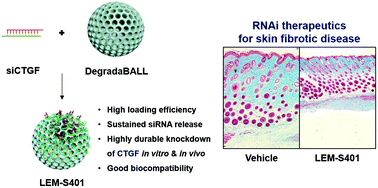RNAi nanotherapy for fibrosis: highly durable knockdown of CTGF/CCN-2 using siRNA-DegradaBALL (LEM-S401) to treat skin fibrotic diseases†
Abstract
Skin fibrosis occurs in a variety of human diseases but the current anti-fibrosis treatments are not sufficient. One major cause of fibrotic diseases shared across diverse organ fibrosis is uncontrolled overexpression of the connective tissue growth factor (CTGF, also known as CCN2). Here, we examine the anti-fibrotic activity of RNAi therapy utilizing siRNA against CTGF with a new drug delivery system (DDS), ‘DegradaBALL’, which is based on porous nanoparticles, for durable CTGF gene silencing. DegradaBALL is a modular DDS having many favorable properties for RNA delivery such as effective intracellular uptake, convenient drug loading, biocompatibility, sustained release profile and biodegradability. DegradaBALL loaded with siCTGF, named ‘LEM-S401’, showed highly durable and effective CTGF gene-silencing in TGF-β induced lung fibrosis and skin fibrosis model cells, A549 and HaCaT, respectively. In addition, LEM-S401 induced knockdown of collagen types I and III, which are excess extracellular matrix components in fibrotic skin in addition to CTGF in the mouse wound healing model. Most importantly, we showed that LEM-S401 effectively inhibited the formation of hypertrophic scars in wound-associated dermal fibrosis mouse models, during both the epidermis recovery and tissue remodeling process. Our findings suggest that LEM-S401 could be a highly potent therapeutic option for skin fibrotic diseases.



 Please wait while we load your content...
Please wait while we load your content...